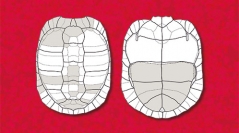

 Geodiversitas
43 (20) - Pages 691-707
Geodiversitas
43 (20) - Pages 691-707Fossil turtles from Mokrá-Quarry, South Moravia Region, Czech Republic, are described in this paper. Remains come from two already known karstic fissures uncovered in Mokrá-Western Quarry (1/2001 Turtle Joint and 2/2003 Reptile Joint), as well as three new karstic fissures from Mokrá-Western Quarry (TC/2001 and 4/2018) and Mokrá-Central Quarry (3/2005). All localities correspond to the early Miocene (Burdigalian: late Eggenburgian-Ottnangian MN4). The newly described material belongs to several turtle individuals, including over 100 shell elements, so the material studied here constitutes one of the largest samples in regards of the Czech Republic fossil record. Most of these remains have been identified as Ptychogaster (Ptychogaster) sp. and Testudo (Chersine) cf. kalksburgensis Toula, 1896. However, three specimens presented here (i.e., one shell fragment and two postcranial bones) have been identified as a large tortoise (Testudinidae indet.). Turtle fauna is congruent with two ecological environments, including a dry karst landscape with open to dense steppe vegetation inferred for the heliophile testudinids, as well as freshwater masses to the semi-terrestrial ptychogasterid. Finally, this paper expands our knowledge of fossil turtle assemblages in Central Europe during the early Miocene.
Early Miocene, Burdigalian, Ptychogaster, Testudo kalksburgensis, Chersine, Czech Republic, Central Paratethys, Carpathian Foredeep Basin